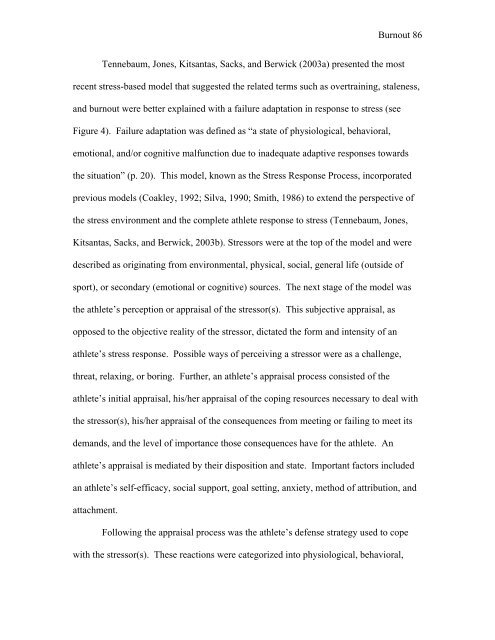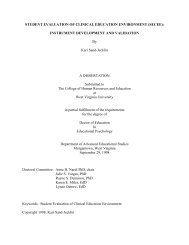Coach and Athlete Burnout - West Virginia University
Coach and Athlete Burnout - West Virginia University
Coach and Athlete Burnout - West Virginia University
You also want an ePaper? Increase the reach of your titles
YUMPU automatically turns print PDFs into web optimized ePapers that Google loves.
<strong>Burnout</strong> 86<br />
Tennebaum, Jones, Kitsantas, Sacks, <strong>and</strong> Berwick (2003a) presented the most<br />
recent stress-based model that suggested the related terms such as overtraining, staleness,<br />
<strong>and</strong> burnout were better explained with a failure adaptation in response to stress (see<br />
Figure 4). Failure adaptation was defined as “a state of physiological, behavioral,<br />
emotional, <strong>and</strong>/or cognitive malfunction due to inadequate adaptive responses towards<br />
the situation” (p. 20). This model, known as the Stress Response Process, incorporated<br />
previous models (Coakley, 1992; Silva, 1990; Smith, 1986) to extend the perspective of<br />
the stress environment <strong>and</strong> the complete athlete response to stress (Tennebaum, Jones,<br />
Kitsantas, Sacks, <strong>and</strong> Berwick, 2003b). Stressors were at the top of the model <strong>and</strong> were<br />
described as originating from environmental, physical, social, general life (outside of<br />
sport), or secondary (emotional or cognitive) sources. The next stage of the model was<br />
the athlete’s perception or appraisal of the stressor(s). This subjective appraisal, as<br />
opposed to the objective reality of the stressor, dictated the form <strong>and</strong> intensity of an<br />
athlete’s stress response. Possible ways of perceiving a stressor were as a challenge,<br />
threat, relaxing, or boring. Further, an athlete’s appraisal process consisted of the<br />
athlete’s initial appraisal, his/her appraisal of the coping resources necessary to deal with<br />
the stressor(s), his/her appraisal of the consequences from meeting or failing to meet its<br />
dem<strong>and</strong>s, <strong>and</strong> the level of importance those consequences have for the athlete. An<br />
athlete’s appraisal is mediated by their disposition <strong>and</strong> state. Important factors included<br />
an athlete’s self-efficacy, social support, goal setting, anxiety, method of attribution, <strong>and</strong><br />
attachment.<br />
Following the appraisal process was the athlete’s defense strategy used to cope<br />
with the stressor(s). These reactions were categorized into physiological, behavioral,












